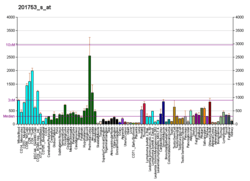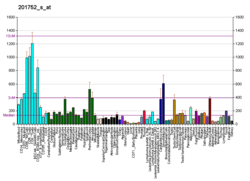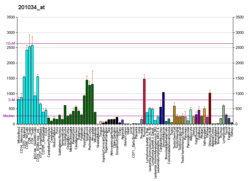ADD3
Gamma-adducin is a protein that in humans is encoded by the ADD3 gene.[5][6]
Adducins are heteromeric proteins composed of different subunits referred to as adducin alpha, beta and gamma. The three subunits are encoded by distinct genes and belong to a family of membrane skeletal proteins involved in the assembly of spectrin-actin network in erythrocytes and at sites of cell-cell contact in epithelial tissues. While adducins alpha and gamma are ubiquitously expressed, the expression of adducin beta is restricted to brain and hematopoietic tissues. Adducin, originally purified from human erythrocytes, was found to be a heterodimer of adducins alpha and beta. Polymorphisms resulting in amino acid substitutions in these two subunits have been associated with the regulation of blood pressure in an animal model of hypertension. Heterodimers consisting of alpha and gamma subunits have also been described. Structurally, each subunit is composed of two distinct domains. The amino-terminal region is protease-resistant and globular in shape, while the carboxy-terminal region is protease-sensitive. The latter contains multiple phosphorylation sites for protein kinase C, the binding site for calmodulin, and is required for association with spectrin and actin. Alternatively spliced adducin gamma transcripts encoding different isoforms have been described. The functions of the different isoforms are not known.[6]
References
- GRCh38: Ensembl release 89: ENSG00000148700 - Ensembl, May 2017
- GRCm38: Ensembl release 89: ENSMUSG00000025026 - Ensembl, May 2017
- "Human PubMed Reference:". National Center for Biotechnology Information, U.S. National Library of Medicine.
- "Mouse PubMed Reference:". National Center for Biotechnology Information, U.S. National Library of Medicine.
- Katagiri T, Ozaki K, Fujiwara T, Shimizu F, Kawai A, Okuno S, Suzuki M, Nakamura Y, Takahashi E, Hirai Y (Dec 1996). "Cloning, expression and chromosome mapping of adducin-like 70 (ADDL), a human cDNA highly homologous to human erythrocyte adducin". Cytogenet Cell Genet. 74 (1–2): 90–5. doi:10.1159/000134389. PMID 8893809.
- "Entrez Gene: ADD3 adducin 3 (gamma)".
External links
- Human ADD3 genome location and ADD3 gene details page in the UCSC Genome Browser.
Further reading
- Kaiser HW, O'Keefe E, Bennett V (1989). "Adducin: Ca++-dependent association with sites of cell-cell contact". J. Cell Biol. 109 (2): 557–69. doi:10.1083/jcb.109.2.557. PMC 2115715. PMID 2503523.
- Maruyama K, Sugano S (1994). "Oligo-capping: a simple method to replace the cap structure of eukaryotic mRNAs with oligoribonucleotides". Gene. 138 (1–2): 171–4. doi:10.1016/0378-1119(94)90802-8. PMID 8125298.
- Suzuki Y, Yoshitomo-Nakagawa K, Maruyama K, et al. (1997). "Construction and characterization of a full length-enriched and a 5'-end-enriched cDNA library". Gene. 200 (1–2): 149–56. doi:10.1016/S0378-1119(97)00411-3. PMID 9373149.
- Gilligan DM, Lozovatsky L, Gwynn B, et al. (1999). "Targeted disruption of the β adducin gene (Add2) causes red blood cell spherocytosis in mice". Proc. Natl. Acad. Sci. U.S.A. 96 (19): 10717–22. doi:10.1073/pnas.96.19.10717. PMC 17949. PMID 10485892.
- Citterio L, Azzani T, Duga S, Bianchi G (2000). "Genomic organization of the human gamma adducin gene". Biochem. Biophys. Res. Commun. 266 (1): 110–4. doi:10.1006/bbrc.1999.1769. PMID 10581174.
- Gilligan DM, Sarid R, Weese J (2002). "Adducin in platelets: activation-induced phosphorylation by PKC and proteolysis by calpain". Blood. 99 (7): 2418–26. doi:10.1182/blood.V99.7.2418. PMID 11895774.
- Strausberg RL, Feingold EA, Grouse LH, et al. (2003). "Generation and initial analysis of more than 15,000 full-length human and mouse cDNA sequences". Proc. Natl. Acad. Sci. U.S.A. 99 (26): 16899–903. doi:10.1073/pnas.242603899. PMC 139241. PMID 12477932.
- Gerhard DS, Wagner L, Feingold EA, et al. (2004). "The Status, Quality, and Expansion of the NIH Full-Length cDNA Project: The Mammalian Gene Collection (MGC)". Genome Res. 14 (10B): 2121–7. doi:10.1101/gr.2596504. PMC 528928. PMID 15489334.
- Gocke CB, Yu H, Kang J (2005). "Systematic identification and analysis of mammalian small ubiquitin-like modifier substrates". J. Biol. Chem. 280 (6): 5004–12. doi:10.1074/jbc.M411718200. PMID 15561718.
- Lanzani C, Citterio L, Jankaricova M, et al. (2005). "Role of the adducin family genes in human essential hypertension". J. Hypertens. 23 (3): 543–9. doi:10.1097/01.hjh.0000160210.48479.78. PMID 15716695.
- Yenerel MN, Sundell IB, Weese J, et al. (2005). "Expression of adducin genes during erythropoiesis: a novel erythroid promoter for ADD2". Exp. Hematol. 33 (7): 758–66. doi:10.1016/j.exphem.2005.03.015. PMID 15963851.
- Olsen JV, Blagoev B, Gnad F, et al. (2006). "Global, in vivo, and site-specific phosphorylation dynamics in signaling networks". Cell. 127 (3): 635–48. doi:10.1016/j.cell.2006.09.026. PMID 17081983.






